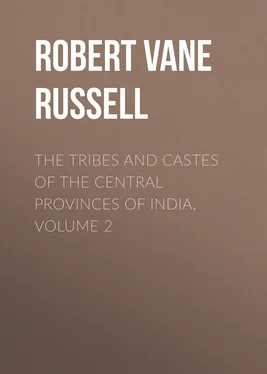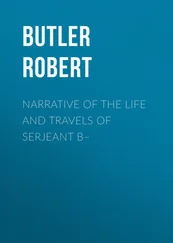Robert Vane Russell - The Tribes and Castes of the Central Provinces of India, Volume 2
Здесь есть возможность читать онлайн «Robert Vane Russell - The Tribes and Castes of the Central Provinces of India, Volume 2» — ознакомительный отрывок электронной книги совершенно бесплатно, а после прочтения отрывка купить полную версию. В некоторых случаях можно слушать аудио, скачать через торрент в формате fb2 и присутствует краткое содержание. Жанр: foreign_prose, История, foreign_edu, foreign_antique, на английском языке. Описание произведения, (предисловие) а так же отзывы посетителей доступны на портале библиотеки ЛибКат.
- Название:The Tribes and Castes of the Central Provinces of India, Volume 2
- Автор:
- Жанр:
- Год:неизвестен
- ISBN:нет данных
- Рейтинг книги:4 / 5. Голосов: 1
-
Избранное:Добавить в избранное
- Отзывы:
-
Ваша оценка:
- 80
- 1
- 2
- 3
- 4
- 5
The Tribes and Castes of the Central Provinces of India, Volume 2: краткое содержание, описание и аннотация
Предлагаем к чтению аннотацию, описание, краткое содержание или предисловие (зависит от того, что написал сам автор книги «The Tribes and Castes of the Central Provinces of India, Volume 2»). Если вы не нашли необходимую информацию о книге — напишите в комментариях, мы постараемся отыскать её.
The Tribes and Castes of the Central Provinces of India, Volume 2 — читать онлайн ознакомительный отрывок
Ниже представлен текст книги, разбитый по страницам. Система сохранения места последней прочитанной страницы, позволяет с удобством читать онлайн бесплатно книгу «The Tribes and Castes of the Central Provinces of India, Volume 2», без необходимости каждый раз заново искать на чём Вы остановились. Поставьте закладку, и сможете в любой момент перейти на страницу, на которой закончили чтение.
Интервал:
Закладка:
14. The Badhaks or Baoris at the present time.
The Badhaks still exist, and are well known as one of the worst classes of criminals, practising ordinary house-breaking and theft. The name Badhak is now less commonly used than those of Bāgri and Baori or Bāwaria, both of which were borne by the original Badhaks. The word Bāgri is derived from a tract of country in Mālwa which is known as the Bāgar or ‘hedge of thorns,’ because it is surrounded on all sides by wooded hills. 64 64 Malcolm’s Memoir of Central India , ii. p. 479.
There are Bāgri Jāts and Bāgri Rājpūts, many of whom are now highly respectable landholders. Bāwaria or Baori is derived from bānwar , a creeper, or the tendril of a vine, and hence a noose made originally from some fibrous plant and used for trapping animals, this being one of the primary occupations of the tribe. 65 65 Crooke’s Tribes and Castes , art. Bāwaria.
The term Badhak signifies a hunter or fowler, hence a robber or murderer (Platts). The Bāgris and Bāwarias are sometimes considered to be separate communities, but it is doubtful whether there is any real distinction between them. In Bombay the Bāgris are known as Vāghris by the common change of b into v . A good description of them is contained in Appendix C to Mr. Bhimbhai Kirpārām’s volume Hindus of Gujarat in the Bombay Gazetteer . He divides them into the Chunaria or lime-burners, the Dātonia or sellers of twig tooth-brushes, and two other groups, and states that, “They also keep fowls and sell eggs, catch birds and go as shikāris or hunters. They traffic in green parrots, which they buy from Bhīls and sell for a profit.”
15. Lizard-hunting.
Their strength and powers of endurance are great, the same writer states, and they consider that these qualities are obtained by the eating of the goh and sāndha or iguana lizards, which a Vāghri prizes very highly. This is also the case with the Bāwarias of the Punjab, who go out hunting lizards in the rains and may be seen returning with baskets full of live lizards, which exist for days without food and are killed and eaten fresh by degrees. Their method of hunting the lizard is described by Mr. Wilson as follows: 66 66 Sirsa Settlement Report.
“The lizard lives on grass, cannot bite severely, and is sluggish in his movements, so that he is easily caught. He digs a hole for himself of no great depth, and the easiest way to take him is to look out for the scarcely perceptible airhole and dig him out; but there are various ways of saving oneself this trouble. One, which I have seen, takes advantage of a habit the lizard has in cold weather (when he never comes out of his hole) of coming to the mouth for air and warmth. The Chūhra or other sportsman puts off his shoes and steals along the prairie till he sees signs of a lizard’s hole. This he approaches on tiptoe, raising over his head with both hands a mallet with a round sharp point, and fixing his eyes intently upon the hole. When close enough he brings down his mallet with all his might on the ground just behind the mouth of the hole, and is often successful in breaking the lizard’s back before he awakes to a sense of his danger. Another plan, which I have not seen, is to tie a wisp of grass to a long stick and move it over the hole so as to make a rustling noise. The lizard within thinks, ‘Oh here’s a snake! I may as well give in,’ and comes to the mouth of the hole, putting out his tail first so that he may not see his executioner. The sportsman seizes his tail and snatches him out before he has time to learn his mistake.” This common fondness for lizards is a point in favour of a connection between the Gujarāt Vāghris and the Punjab Bāwarias.
16. Social observances.
In Sirsa the great mass of the Bāwarias are not given to crime, and in Gujarāt also they do not appear to have special criminal tendencies. It is a curious point, however, that Mr. Bhimbhai Kirpārām emphasises the chastity of the women of the Gujarāt Vāghris. 67 67 It would appear that the Gujarāt Vāghris are a distinct class from the criminal section of the tribe.
“When a family returns home after a money-making tour to Bombay or some other city, the women are taken before Vihāt (Devi), and with the women is brought a buffalo or a sheep that is tethered in front of Vihāt’s shrine. They must confess all, even their slightest shortcomings, such as the following: ‘Two weeks ago, when begging in Pārsi Bazār-street, a drunken sailor caught me by the hand. Another day a Mīyan or Musalmān ogled me, and forgive me, Devi, my looks encouraged him.’ If Devi is satisfied the sheep or buffalo shivers, and is then sacrificed and provides a feast for the caste.” 68 68 Bombay Gazetteer , Gujarāt Hindus , p. 514.
On the other hand, Mr. Crooke states 69 69 Art. Bawaria, quoting from North Indian Notes and Queries , i. 51.
that in northern India, “The standard of morality is very low because in Muzaffarnagar it is extremely rare for a Bāwaria woman to live with her husband. Almost invariably she lives with another man: but the official husband is responsible for the children.” The great difference in the standard of morality is certainly surprising.
In Gujarāt 70 70 Bombay Gazetteer , Hindus of Gujarāt , p. 574.
the Vāghris have gurus or religious preceptors of their own. These men take an eight-anna silver piece and whisper in the ear of their disciples “Be immortal.”… “The Bhuvas or priest-mediums play an important part in many Vāghri ceremonies. A Bhuva is a male child born after the mother has made a vow to the goddess Vihāt or Devi that if a son be granted to her she will devote him to the service of the goddess. No Bhuva may cut or shave his hair on pain of a fine of ten rupees, and no Bhuva may eat carrion or food cooked by a Muhammadan.”
17. Criminal practices.
The criminal Bāgris still usually travel about in the disguise of Gosains and Bairāgis, and are very difficult of detection except to real religious mendicants. Their housebreaking implement or jemmy is known as Gyān , but in speaking of it they always add Dās , so that it sounds like the name of a Bairāgi. 71 71 Gunthorpe’s Criminal Tribes .
They are usually very much afraid of the gyān being discovered on their persons, and are careful to bury it in the ground at each halting-place, while on the march it may be concealed in a pack-saddle. The means of identifying them, Mr. Kennedy remarks, 72 72 Criminal Classes in the Bombay Presidency , p. 151.
is by their family deo or god, which they carry about when wandering with their families. It consists of a brass or copper box containing grains of wheat and the seeds of a creeper, both soaked in ghī (melted butter). The box with a peacock’s feather and a bell is wrapped in two white and then in two red cloths, one of the white cloths having the print of a man’s hand dipped in goat’s blood upon it. The grains of wheat are used for taking the omens, a few being thrown up at sun-down and counted afterwards to see whether they are odd or even. When even, two grains are placed on the right hand of the omen-taker, and if this occurs three times running the auspices are considered to be favourable. 73 73 Gunthorpe’s Criminal Tribes , art. Badhak.
Mr. Gayer 74 74 C. P. Police Lectures , art. Badhak.
notes that the Badhaks have usually from one to three brands from a hot iron on the inside of their left wrist. Those of them who are hunters brand the muscles of the left wrist in order to steady the hand when firing their matchlocks. The customs of wearing a peculiar necklace of small wooden beads and a kind of gold pin fixed to the front teeth, which Mr. Crooke 75 75 Art. Bāwaria, para. 12.
records as having been prevalent some years ago, have apparently been since abandoned, as they are not mentioned in more recent accounts. The Dehliwāl and Mālpura Baorias have, Mr. Kennedy states, 76 76 Criminal Classes in the Bombay Presidency , p. 179.
an interesting system of signs, which they mark on the walls of buildings at important corners, bridges and cross-roads and on the ground by the roadside with a stick, if no building is handy. The commonest is a loop, the straight line indicating the direction a gang or individual has taken:
Интервал:
Закладка:
Похожие книги на «The Tribes and Castes of the Central Provinces of India, Volume 2»
Представляем Вашему вниманию похожие книги на «The Tribes and Castes of the Central Provinces of India, Volume 2» списком для выбора. Мы отобрали схожую по названию и смыслу литературу в надежде предоставить читателям больше вариантов отыскать новые, интересные, ещё непрочитанные произведения.
Обсуждение, отзывы о книге «The Tribes and Castes of the Central Provinces of India, Volume 2» и просто собственные мнения читателей. Оставьте ваши комментарии, напишите, что Вы думаете о произведении, его смысле или главных героях. Укажите что конкретно понравилось, а что нет, и почему Вы так считаете.












